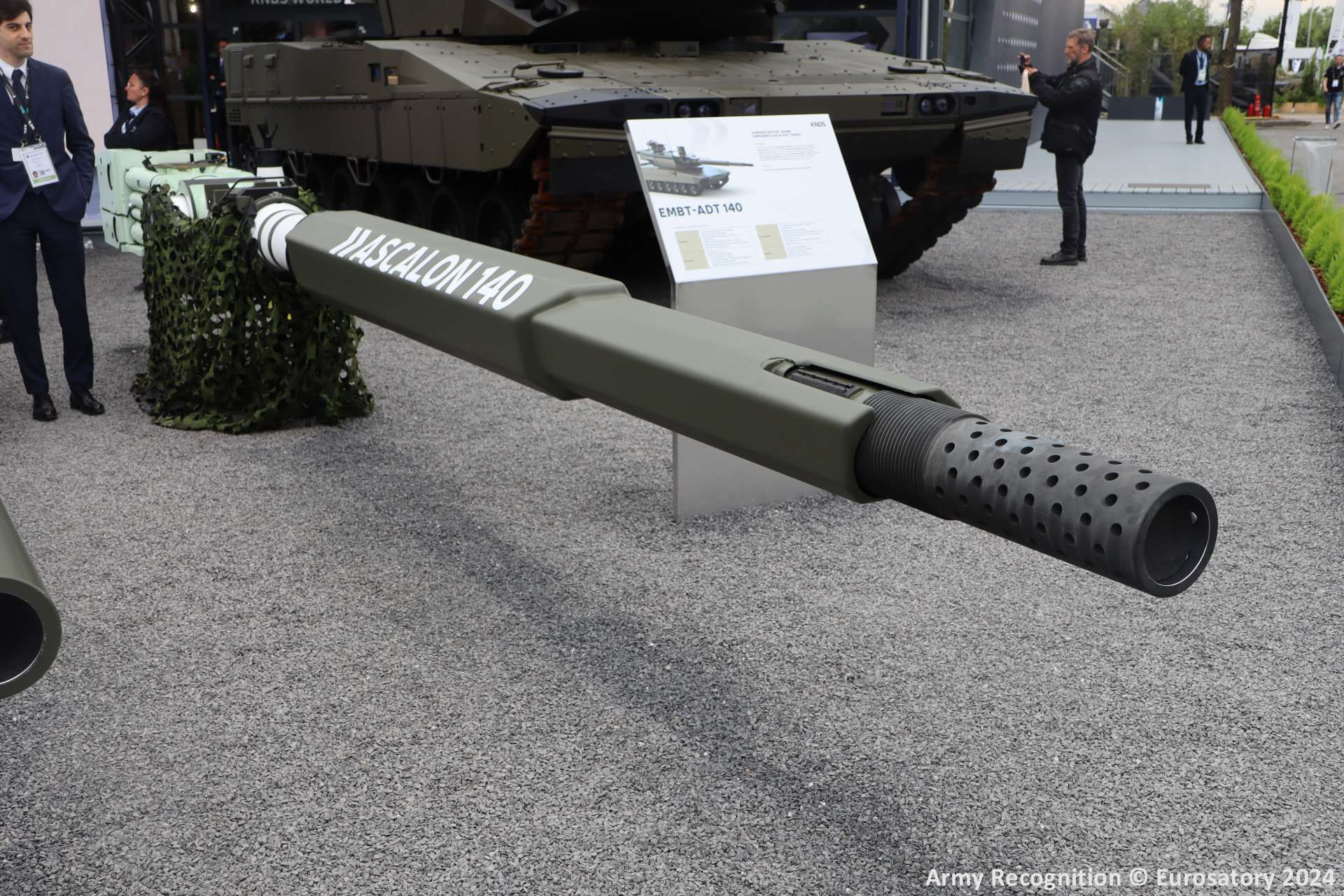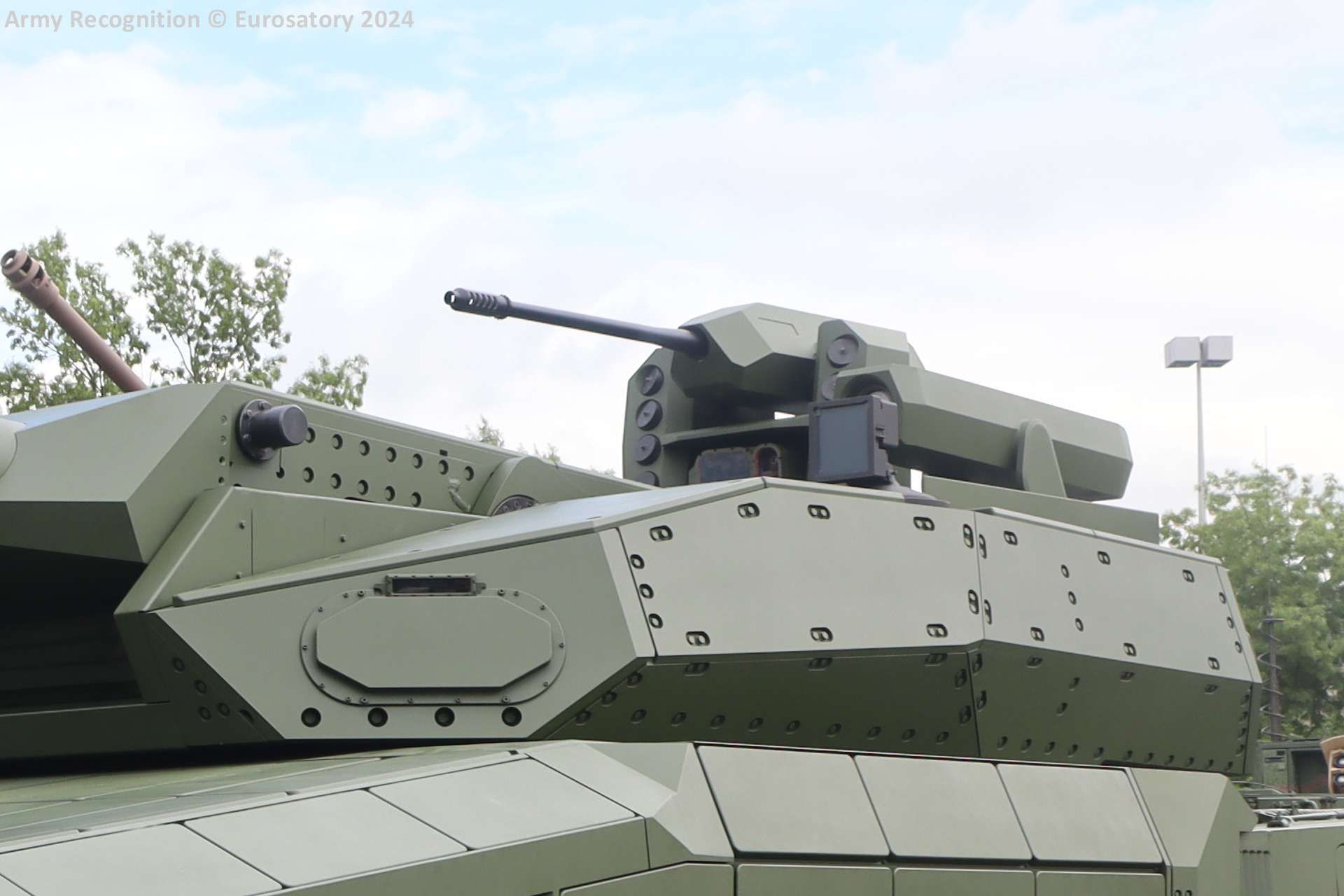Breaking News
Future of Main Battle Tanks: Episode 4 at Eurosatory - KNDS Germany's new Leopard 2 A-RC 3.0.
In this fourth episode of our series on the main battle tanks showcased at the Eurosatory 2024 exhibition, we will focus on one of the most awaited tanks of the show: the Leopard 2 A-RC 3.0 from KNDS Germany, a tank intended to serve as a transitional Main Battle Tank before the Main Ground Combat System (MGCS) becomes operational in the late 2030s. Representing a notable upgrade over its predecessors within the Leopard 2 series, this tank possesses features such as an unmanned turret, a modular autoloader system, and an AI-powered sensor suite designed to enhance battlefield effectiveness.
Follow Army Recognition on Google News at this link

The turret's design includes two pivot points, known as trunnions, ensuring the gun remains level above the chassis at all times. This results in a flat turret design that reduces the occupied vulnerable area by 30%. (Picture source: Army Recognition)
The shift to an unmanned turret was a deliberate choice, as explained by Dr. Axel Scheibel, KNDS Germany's Chief Technology Officer, during the unveiling ceremony. This configuration, based on components previously seen on the Tracked Boxer, removes the need for a basket, thereby increasing the available space within the chassis to position the three-man crew (commander, gunner, and driver) under the turret, as it does not intrude into the chassis. Artificial intelligence (AI) algorithms and robotic systems replace the fourth crew member in handling simpler issues and reduce workload by providing only necessary information relative to the situation. Dr. Scheibel noted the implementation of degraded modes to ensure the tank remains operational even when systems fail.
The turret's design includes two pivot points, known as trunnions, which allow for gun rotation without intrusion, ensuring the gun remains level above the chassis at all times. This results in a flat turret design that reduces the occupied vulnerable area by 30%. This configuration enables a 10° depression and approximately 25° maximum elevation. The Leopard 2 A-RC 3.0's turret is also designed to accommodate various main gun calibers, ranging from 120 to 140 mm, making it compatible with all current and future NATO tank guns, including the 120 mm L44 and L55 smoothbore guns, Rheinmetall's Rh-130/51 mm gun (used by the KF-51 Panther), and the KNDS Ascalon gun system, either in 120 or 140 mm. This adaptability ensures that armies can start with existing 120 mm smoothbore guns and upgrade to larger calibers in the future without purchasing a completely new fleet of tanks.

The Leopard 2 A-RC 3.0 is compatible with all current and future NATO tank guns, including the 120 mm L44 and L55 smoothbore guns, Rheinmetall's Rh-130/51 mm gun (used by the KF-51 Panther), and the KNDS Ascalon gun system, either in 120 or 140 mm. (Picture source: Army Recognition)
For the Leopard 2 A-RC 3.0, KNDS Deutschland developed a modular autoloader system inspired by soda bottle dispensers, with the ramming system at the center and rows of ammunition on either side. This system can feed three initial rounds to the barrel within 10 seconds, providing a quicker reloading rate compared to current systems used by Western tanks. Housed within the turret, the autoloader hosts 20 rounds in two rows of 10 each, ensuring balanced turret weight distribution and operational efficiency during engagements.
Secondary armament includes eight multi-purpose smoke and grenade launchers, with four on each side, and a Remote Controlled Weapon Station (RCWS) armed with a NATO 30x113 mm gun capable of countering UAV threats. The RCWS also includes the commander’s panoramic sight for improved cost efficiency. For longer-range engagements, a multi-purpose guided missile system for both line-of-sight (LOS) and non-line-of-sight (NLOS) scenarios is installed on the left side of the turret and is raised only when necessary, a solution seen on the TOW missile launcher from the American Bradley Fighting Vehicle.
Dr. Scheibel stated that the unmanned turret allowed for the optimization of the protection package, considering new threats like drones and loitering munitions with a top-down attack profile. The crew's relocation inside the hull, mostly under the turret, enhances shielding against top attack threats, creating three defeating lines: the turret ceiling, the space within the turret, and the chassis roof. The hull roof has also been raised by around 100 mm to improve ergonomics, with a flat roof extending from the rear to the front glacis. The crew accesses the tank via two sliding hatches located at the front, with an emergency exit available in the floor, similar to previous Leopard 2 models.

Secondary armament includes eight multi-purpose smoke and grenade launchers, a Remote Controlled Weapon Station (RCWS) armed with a 30 mm gun, and a multi-purpose guided missile system for both line-of-sight (LOS) and non-line-of-sight (NLOS) engagements. (Picture source: Army Recognition)
The Leopard 2 A-RC 3.0 can withstand hits from 57 mm rounds, including from the side, addressing the direct fire threat from the latest Russian infantry fighting vehicles like the BMP B-19. The tank's protection is further reinforced with a Trophy active protection system (APS) to counter missiles and RPGs, with ongoing developments to expand its capability against UAV threats. The Leopard 2 A-RC 3.0 is also equipped with a multispectral sensor suite that enhances tactical and situational awareness, including UxV control, optronics, and multiple detection systems such as laser warning, optics detection, and drone detection.
Weighing less than 60 tons due to the unmanned turret module, the Leopard 2 A-RC 3.0 measures 7.95 meters in length, extending to 11.17 meters with the gun, 3.77 meters in width, and 2.44 meters in height to the turret roof, reaching 2.84 meters with the PERI. Its MTU 873 diesel engine, generating 1,100 kW (1,500 HP), coupled with a Renk HSWL 354 gearbox, allows the tank to reach speeds exceeding 65 km/h and a range of 460 km on the road. The ground clearance of 500 mm ensures effective navigation across various terrains.
Looking ahead, KNDS Deutschland aims to showcase a fully operational demonstrator of the Leopard 2 A-RC 3.0 by 2026, refining its chassis design based on feedback from potential users such as the German armed forces (Bundeswehr). KNDS Deutschland aims to offer this new variant as an update to existing Leopard 2 models, from the A4 to the A8 standard. The turret will be replaced by the new design, while the rear part of the hull remains unchanged, and the front part will be modified to accommodate the new crew positions.

KNDS Deutschland aims to showcase a fully operational demonstrator of the Leopard 2 A-RC 3.0 by 2026, refining its chassis design based on feedback from potential users such as the German armed forces (Bundeswehr). (Picture source: Army Recognition)


























